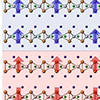| Dec 06, 2022 |
|
(Nanowerk News) In a study published in Advanced Materials (“Emergent, Non-Aging, Extendable, and Rechargeable Exchange Bias in 2D Fe3GeTe2 Homostructures Induced by Moderate Pressuring”), researchers from the Hefei Institutes of Physical Science of the Chinese Academy of Sciences have developed a new type of two-dimensional homogeneous bias device with moderate pressure in cooperation with researchers from University of Science and Technology of China.
|
|
Compared with three-dimensional similar devices, the two-dimensional bias device was described as “non-aging, extensible and recoverable.”
|
|
“It provides a new idea for the design of low-dimensional magnetic devices and the study of exchange bias effect mechanism,” said SHENG Zhigao, who led the team, “and we expect it to become the core magnetic components in two-dimensional electronic technology and equipment.”
|
 |
| Magnetic transition of Fe3GeTe2 induced by uniaxial compression, magneto-optical phenomenon of Fe3GeTe2 after compression and exchange bias effect of Fe3GeTe2 non-aging, extensible and recoverable. (Image: HOU De)
|
|
Two-dimensional Van der Waals magnetic materials provide an excellent platform for basic magnetic research and low-dimensional magnetic device development due to their layered structure, no dangling bond surface and strong magnetic anisotropy. However, the weak interlayer coupling greatly limits the application of two-dimensional magnetic material functional devices. Therefore, how to effectively achieve strong magnetic exchange through interface engineering has become one of the key issues in the construction of two-dimensional magnetic devices.
|
|
In this study, the researchers tried lots of materials and technical methods. They found that the two-dimensional iron germanium tellurium (Fe3GeTe2) material with ferromagnetic ground state can be induced into a homogeneous and magnetic heterostructure with ferromagnetic-antiferromagnetic coexistence by uniaxial pressure technology.
|
|
At the same time, they discovered that the structure has a practical exchange bias effect.
|
|
This pressure-induced phase transition was confirmed by magneto-optical testing, high-resolution transmission electron microscopy, and first-principles calculations.
|
|
Since the ferromagnetic-antiferromagnetic coupling of the homogeneous and magnetic heterostructure of the material occurs inside the homogeneous junction, its exchange bias effect exhibited excellent characteristics thanks to the atomically smooth magnetic interface.
|
|
“These features (non-aging, extendable, and rechargeable) cannot be found in three-dimensional devices,” said HOU De, member of the team.
|
|
The results pave a new way for the design and development of high-performance two-dimensional magnetic devices, and their excellent exchange bias characteristics provide an opportunity for the effective application of two-dimensional magnetic devices.
|


